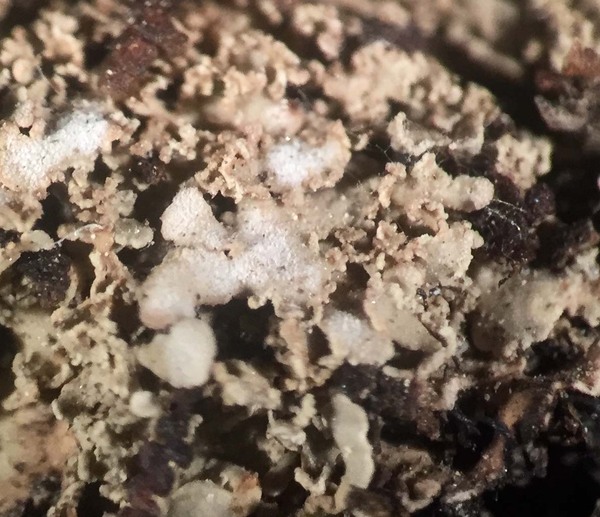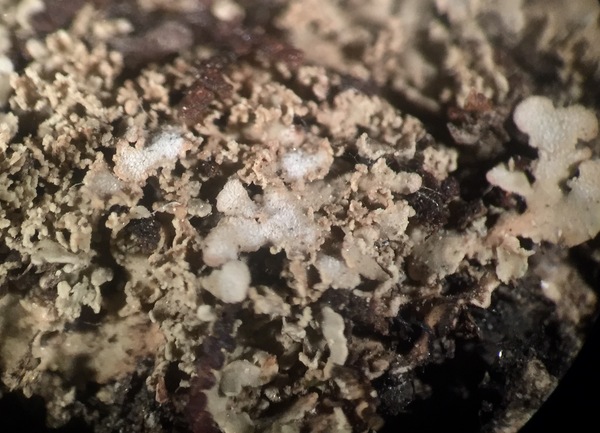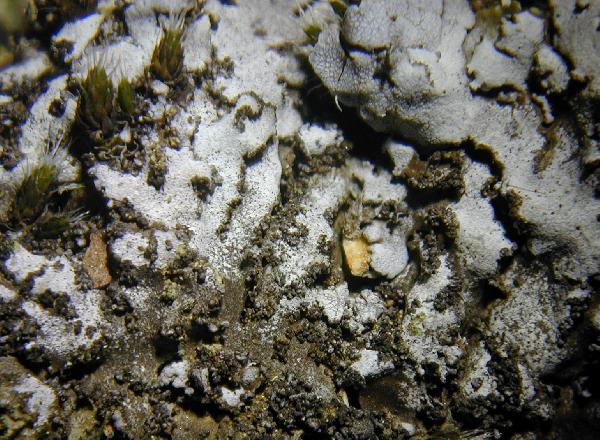Physconia subpulverulenta (Szatala) Poelt var. atlantica Poelt
Nova Hedwigia, 12: 127, 1966.
Synonyms:
Distribution: C - Sar (Zedda 1995, 2002, Zedda & Sipman 2001).
Description: Thallus foliose, heteromerous, dorsiventral, narrow-lobed, rather tightly adpressed, forming up to 6 cm wide rosettes. Lobes elongate, 0.5-1(-1.3) mm wide, rather thin, flat to concave, of variable colour, from brown in weakly pruinose forms to white in strongly pruinose ones, with a coarse white pruina at least at tips, with numerous, cylindrical to slightly flattened, mostly marginal isidia-like outgrowths. Lower surface mostly black (whitish in marginal parts), with dense, dark, squarrose rhizines. Upper and lower cortex prosoplectenchymatous, the hyphae mostly running perpendicularly to the surface; medulla yellowish. Apothecia lecanorine, sessile, to 3 mm across, with a usually white-pruinose disc and a persistent, often lobulate thalline margin, the lobules usually isidiate. Epithecium brown; hymenium and hypothecium colourless; paraphyses slender, simple or forked in upper part, the apical cells clavate, with a thin, dark brown cap. Asci 8-spored, clavate, the K/I+ blue tholus penetrated by a faintly amyloid apical cushion with parallel or diverging flanks, the wall K/I-, surrounded by a K/I+ blue outer layer, Lecanora-type. Ascospores 1-septate, brown, ellipsoid, 24-30 x 12-18 μm, thickened at septum but not at apices, Physconia-type. Photobiont chlorococcoid. Spot tests: upper cortex K-, C-, KC-, P-; medulla K+ yellow, C+ yellow, KC+ yellow-orange, P-. Chemistry: medulla with variolaric acid.Note: a critical taxon, which needs further study. It was included in the Italian red list of epiphytic lichens as “Data Deficient” (Nascimbene & al. 2013c).
Growth form: Foliose, narrow lobed
Substrata: bark
Photobiont: green algae other than Trentepohlia
Reproductive strategy: mainly sexual
Most common in areas with a humid-warm climate (e.g. most of Tyrrenian Italy)
Poorly known taxon in need of further study
Commonnes-rarity: (info)
Alpine belt: absent
Subalpine belt: absent
Oromediterranean belt: absent
Montane belt: extremely rare
Submediterranean belt: absent
Padanian area: absent
Humid submediterranean belt: absent
Humid mediterranean belt: absent
Dry mediterranean belt: absent

Predictive model
Herbarium samples
Growth form: Foliose, narrow lobed
Substrata: bark
Photobiont: green algae other than Trentepohlia
Reproductive strategy: mainly sexual
Most common in areas with a humid-warm climate (e.g. most of Tyrrenian Italy)
Poorly known taxon in need of further study
Commonnes-rarity: (info)
Alpine belt: absent
Subalpine belt: absent
Oromediterranean belt: absent
Montane belt: extremely rare
Submediterranean belt: absent
Padanian area: absent
Humid submediterranean belt: absent
Humid mediterranean belt: absent
Dry mediterranean belt: absent

Predictive model
| Herbarium samples |





